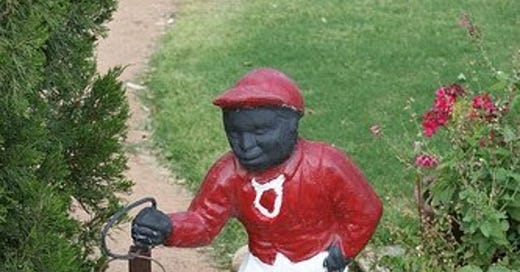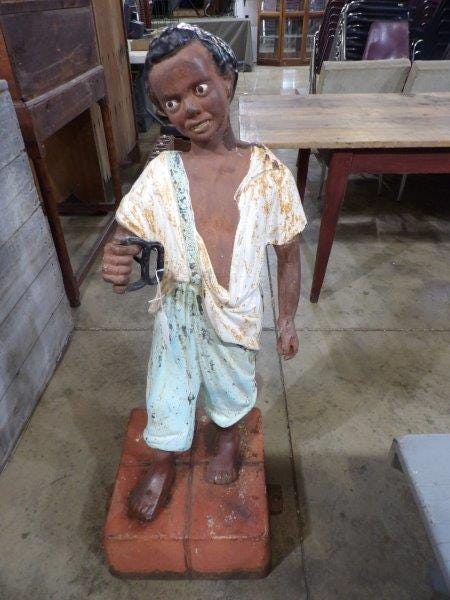A Lawn Jockey is a small statue of a man, historically a black man, in jockey garb holding a lantern on a metal ring. They became popular in the mid-19th century as a hitching post for horses, but in modern times have fallen out of favor. This is partly due to the fact that we no longer have need to hitch our horses, but also because many consider them to be racist relics of the past, which is why modern versions tend to be a white man. But is their history truly one of racism? And why were black men depicted as jockeys?
To be clear, there is a racist past concerning black jockeys. Horse racing, which first became popular in the south, was often entertainment for slave owners, who would use their slaves as jockeys. As the sport became organized and gained recognition, racism forced blacks out and kept them from participating in the sport until about the mid twentieth century. But how did statues of black jockeys become a thing? Were they born of racism?
Actually, no. Though the lawn jockey has had a racist past, it did not have a racist birth. It came about to honor the actions of a 12-year-old boy during the American revolution … tonight, in 1776 … and it was an honor bestowed upon him by none other than the Commander in Chief of the Continental army, General George Washington. His name was Jocko Graves.
Jocko’s father was a black man named Tom Graves who lived in the vicinity of the Continental army after it had been chased across the Delaware river into Pennsylvania. The army was in desperate need of fresh troops, and Washington had put out a call for local militia to join the fight. Tom answered the call, and his son Jocko, who was as eager to fight for the new nation as was his father, answered the call with him.
Morale among the troops was low, and the army was facing extinction in the new year. Already weakened by death and desertion, many of the remaining troop’s enlistments were set to expire on December 31st. A victory was needed to encourage reenlistment, and it was needed it now. Washington decided on a bold move … cross the partially frozen Delaware and surprise the Hessian troops quartered in Trenton. If it worked, the army may actually survive to continue the fight. If it didn’t, well, the war was probably lost anyway.
Washington met Jocko while reviewing the troops prior to the attack and, while he was impressed by Jocko’s patriotic fervor, he deemed him too young to engage in the risky battle to come. Instead, he assigned Jocko the job of “groomsman,” which back then was a person who tended to horses. Washington was limited in the number of horses he could take across the river, and he left the remaining horses in Jocko’s care, along with instruction to keep a lantern lit and visible from the New Jersey side to give his troops a visual reference to help find their way back.
Tonight is the 247th anniversary of Washington’s bold gamble. It is also the 247th anniversary of Jocko’s death. When the troops returned from their victory at Trenton, they found Jocko standing on the banks of the river holding a still lit lantern, though Jocko’s own light had long since faded. Jocko had frozen to death in the harsh winter weather as he kept vigil on the banks of the Delaware to guide the soldiers back home.
Washington never forgot Jocko’s dedication to his duties and the sacrifice he had made in support of the revolution. Years later, after Washington had returned to his beloved Mt. Vernon, he commissioned a cast iron statue of a young black man holding a lantern. He called it “the faithful groomsman,” and placed it on his property as a lasting tribute to Jocko Graves.
In the decades that followed, replicas of a young black man holding either a lantern or a horse hitch, or both, began appearing throughout the south, but the story of the statue’s significance began to fade. It is likely that Jocko’s name morphed into the jockey reference that defined the later versions of the statue, as it shamefully took on more racist characteristics along the lines of a “Sambo” character. It wasn’t until historians began to research the origin of the “lawn Jockey” that Jocko’s story was rediscovered.
Even as Jocko’s service to his nation had been forgotten, the statue inspired by him may have continued to serve our people. Though there is little hard historical evidence of this service, there exists many apocryphal accounts of lawn jockeys serving as signposts along the underground railroad that helped slaves escape to freedom. The legend goes that the colors that lawn jockeys were painted served as secret signals indicating safe houses, or services available to escaping slaves.
In the mid twentieth century, lawn jockeys became popular among white homeowners to symbolize support of civil rights and to indicate that they were not members of the KKK. Toward the end of the century, as America embraced civil rights and rejected organizations like the Klan, the symbolism was once again lost, and the statues again were deemed by many to be racist, though they no longer were cast as “Sambo” characters and, as previously mentioned, were often depicted as white men to avoid the racist charge.
According to African American historian Charles L. Blockson, who is an authority on African American culture and the African diaspora, lawn jockeys are “enduring symbols of black courage and perseverance.” Though the statue’s racist past is far more often remembered than Jocko’s story, his story should be remembered. The next time you see a lawn Jockey, think of Jocko, and take a moment to remember a 12-year-old American and the sacrifice he made for his nation … as well as the many sacrifices that blacks have made for America, and what they’ve had to overcome.
NEXT WEEK: Mutiny at Morristown





